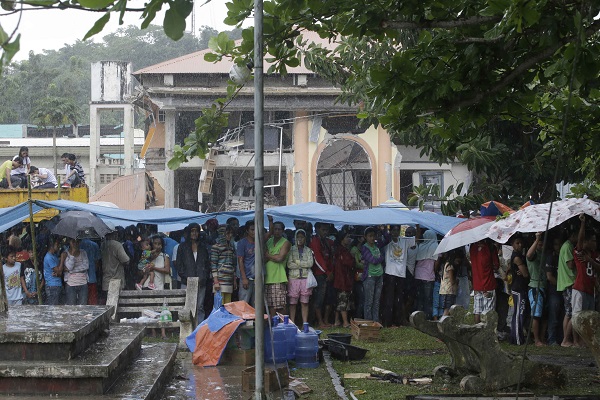
Residents take shelter during a heavy downpour as they queue up to receive “temporary cash transfer” given by the government at quake-hit Sagbayan town, Bohol province, on Oct. 17, 2013. The Department of Social Welfare and Development and Habitat for Humanity recently completed the construction of three makeshift hospital tents in Sagbayan, Carmen and Loon to prevent an outbreak of disease. AP PHOTO
MANILA, Philippines—The Department of Social Welfare and Development (DSWD) and Habitat for Humanity recently completed the construction of three makeshift hospital tents in Carmen, Loon and Sagbayan towns in earthquake-devastated Bohol province to prevent an outbreak of disease and to immediately address the medical needs of the evacuees.
Social Welfare Secretary Dinky Soliman said the hospital tents were manned by doctors from the district hospitals and municipal health officers.
Soliman said hospital tents were also being put up in the towns of Tubigon, Sagbayan, Clarin, Calape, Buenavista and Inabanga.
“Based on the extent of the damage, we are partnering with Habitat for Humanity to provide shelter kits for families with partially destroyed houses, and construct shelters for families with totally damaged houses,” the secretary said.
“The shelter kits are comprised of galvanized iron sheets for roofing, mesh wire, steel bars and other materials for the repair of partially destroyed houses,” she added.
Vince Delector Jr., manager of the Water, Sanitation and Sustainable Operations Team of Habitat for Humanity, said some 10,000 shelter kits will be provided to the affected families while 2,000 core shelters will be built within the next two years.
Delector said Habitat for Humanity will start the construction of permanent shelters in Barangay (village) Mantacida in Catigbian, one of the hardest hit areas.
“In building the houses, we will use bamboo and cement, encasing the shelters in a lightweight steel frame with a cement foundation,” Delector said.
According to Soliman, Habitat for Humanity has been a long-time partner of the DSWD in building shelters for victims of disasters, such as Typhoon “Sendong,” which hit Cagayan de Oro City in 2011 and Typhoon “Pablo,” which devastated the Davao region and Compostela Valley in 2012.
As of Oct. 29, DSWD had recorded a total of 17,793 families staying in 371 evacuation centers in Bohol. Based on the DSWD’s latest validation report, the number of totally damaged houses in the province rose to 12,672.
Evacuation centers in Cebu have closed but 1,364 families, or 6,806 individuals, who are home-based or staying with their relatives or friends continue to receive food assistance from the DSWD and local government units (LGUs).
Meanwhile, Soliman said the devastation brought by the earthquake showed the strong partnership and coordination of the national government and LGUs in times of disaster.
In the aftermath of the earthquake, the DSWD assisted the affected LGUs, working round the clock to bring immediate relief to the shaken communities.
The DSWD, in coordination with the LGUs, specifically the Municipal Social Welfare and Development Officers (MSWDO) of the affected towns, closely monitored the situation, provided relief goods and deployed stress debriefers and counselors for the grieving families.
In the town of Bilar alone, Soliman said, the local government was quick to respond to the needs of the people in Barangay Bonifacio, which was hardest hit by the tremor, while the DSWD identified the different evacuation sites and provided relief goods to affected families.